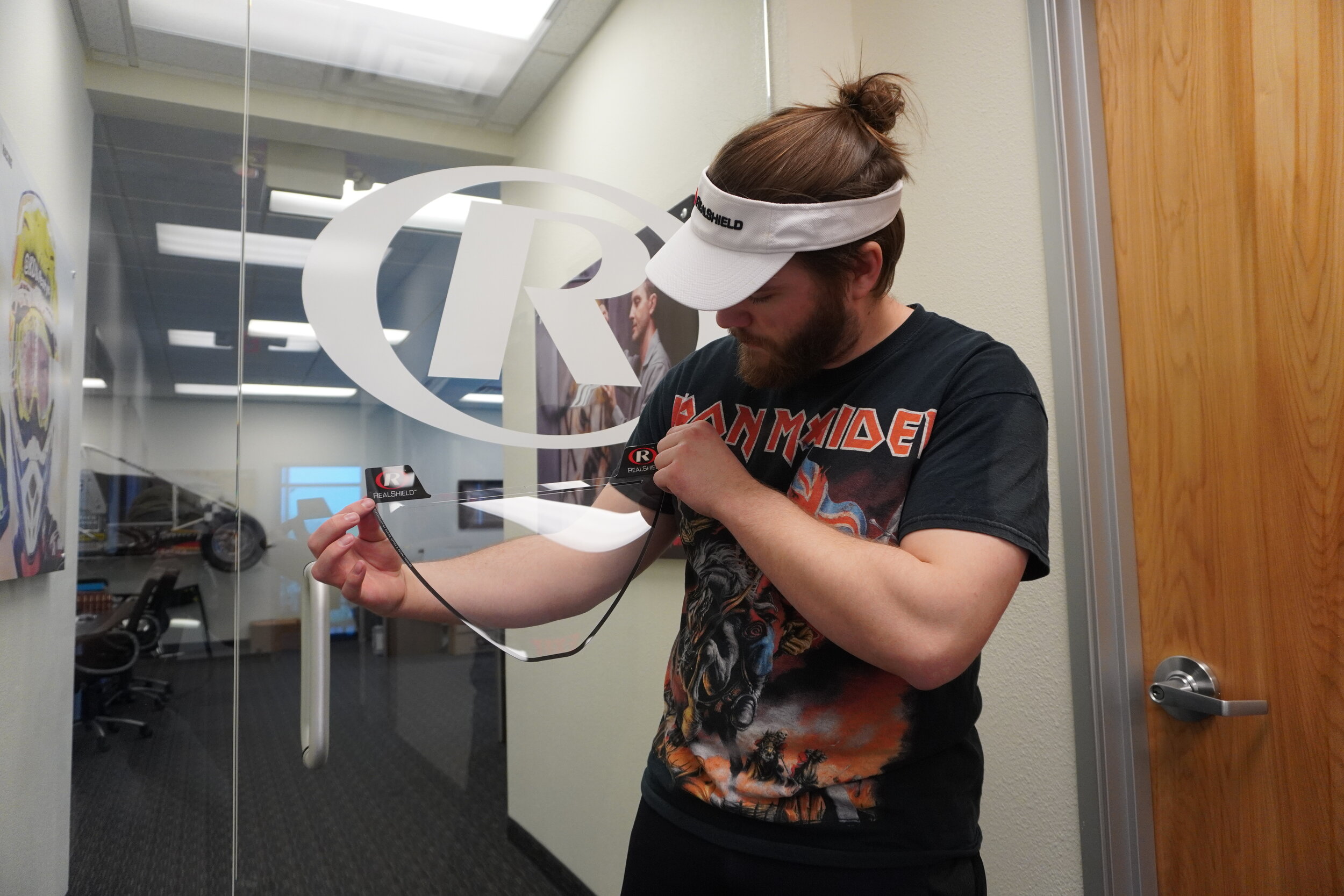How Racing Optics Adapted to the Pandemic
Bo Brusco | April 11, 2020 (8-minute read)
Racing Optics, a family-owned business that manufactures multi-laminated film for motorsports applications, found themselves in a trying situation during the pandemic; racing events were shut down, and shops that carried their products were closed. In order to adapt to the new terrain, Racing Optics began manufacturing PPE in the form of face shields.
Motorsports Racing Interrupted by the Pandemic
Racing Optics is a family-owned company that manufactures multi-laminated film for motorsports applications. Having been in business for more than 20 years, they’re well established in the industry, but when the pandemic struck, that industry quickly shut down.
Motorsports enterprises across the nation were financially affected by the new restrictions. NASCAR, being one of the most prominent corporations in the motorsports industry, lost $175 million in ticket revenue alone, according to sportsmedia.com.
Racing Optics’s location in Las Vegas, Nevada. April 9, 2021. (Photo: Bo Brusco)
Not only did racing events shut down, but the shops that would carry Racing Optics’s product were also temporarily closed. Amidst this never-before-explored terrain, the family-owned company had to find a way to adapt.
“So when the pandemic happened, all racing shut down. All the shops that were buying our stuff, you know, were closing down too,” recalls Gage Wilson, the warehouse manager for the company’s Las Vegas, Nevada location.
Adapting to Unprecedented Times
Wilson recounts how the company managed to stay profitable during the lockdown in 2020. “You know, a lot of people don’t like wearing masks on their faces and we had the line ready to go to make plastic,” he says. “It was just sitting there not doing anything since there was no racing going on. So we thought, you know, let’s just make some face shields with that empty processor.”
Rolls and rolls of multilayered plastic film at Racing Optics’s warehouse in Las Vegas, Nevada. April 9, 2021. (Photo: Bo Brusco)
As early as February 2020, Barton Wilson, Gage’s father and the CEO of Racing Optics, began drafting designs for face shields. Then manufacturing began around April of the same year.
Quality Face Shields
Before the pandemic, their multi-layered material was used to protect motor racers’ goggles and windshields, but now, as Wilson explains, that material was being temporarily repurposed for protective face shields.
Their face shields are described as having been made from a “shatterproof Lexan” material, and according to Wilson, they sold exceptionally well until winter 2020.
Gage Wilson, the warehouse manager at Racing Optics’s Las Vegas location, holds one of the company’s face shields. April 9, 2021. (Photo: Bo Brusco)
By about November, “everyone was getting burnt out,” Wilson recalls. “People by that time just weren’t looking to buy masks anymore, probably because most everyone had already purchased the masks they wanted by then.”
The Amazon Issue
Racing Optics began selling its face shields via Amazon around mid-2020, but the company quickly found that there were pros and cons in doing so. Wilson specifically recalls the increased shipping rates Amazon was charging during the lockdown.
“They force you to pick from predetermined options for shipping,” he explains, “and if I went on to UPS.com and told them I’m shipping this thing from where I am to this customer and printed out a receipt, it’d be like half the price.”
“Whereas when I go through Amazon,” Wilson continues, “and they say, ‘hey, you sold this thing to this person, you have to ship it to them with this shipping label which is going to cost you 75% of the profit from the thing that you just sold them.’ You know?”
Amazon’s worldwide shipping rates shot up with the increased demands during the pandemic. By October 2020, the tycoon’s shipping costs totaled $15 billion, a 57% increase compared to October 2019 when shipping costs totaled around $9 billion, according to Amazon’s 3rd Quarter Earnings Release in 2020.
As a result, shipping items became significantly more expensive, leading to companies like Racing Optics seeing a decrease in their profit margins. “We went from like maybe $8 to ship a box of one face shield to like $15 and $18 to ship a box,” Wilson explains. “And that’s just ground. Two-day and next-night are like triple or quadruple that you know, and one face shield only cost the customer $30.”
In an attempt to resolve the issue, Racing Optics has recently opted for Amazon’s fulfillment services, known as FBA or Fulfilled by Amazon. The service essentially involves companies shipping large amounts of their product to Amazon’s warehouse, where Amazon can fulfill orders as they are received.
While the service is generally more affordable, a noteworthy downside is the storage fee. “Now the only issue is it’s not always going to be more affordable,” Wilson says, referring to FBA services, “because you have to pay them to loan you the space in their warehouse. It’s like however much space you’re taking up in their warehouse, they charge you per square inch or square foot. But we have things that are this big,” he said while motioning to a little paper-sized box containing face shields. “And they’re like ‘this is this many inches in our warehouse,’ you know? It’s not even a square foot, and they’re giving us a pricing graph.”
A race care inside Racing Optics’s shop in Las Vegas, Nevada. April 9, 2021. (Photo: Bo Brusco)
Lessons from the Pandemic
As more and more people are getting vaccinated, a return to normal is likely in the future. But when the pandemic came and the speedway became hazardous, Racing Optics was able to adapt and get back into the race. And while the demand for masks and face shields may continue to decline, Wilson believes the experience was valuable. He says, “the experience overall kind of goes to show that we can roll with the punches.”




